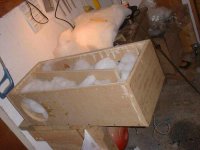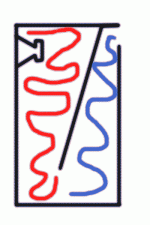For the stuffing inside the TL, theres 0.2 lb/cuFT of that stuffing, I chose stuffing that has long strings, but when i get the tl standing up, the stuffing compressed a bit, I'd imagine it'll get worse when theres bass.... any ideas?
and I cant really figure out the SD from front and rear,
I'm using Martin J. King's software wich is brilliant to make my TL
www.quarter-wave.com (awsome stuff!!)
I have a pic, here im still stuffing it.
and I cant really figure out the SD from front and rear,
I'm using Martin J. King's software wich is brilliant to make my TL
www.quarter-wave.com (awsome stuff!!)
I have a pic, here im still stuffing it.
Attachments
Hi Ilianh,
Thanks for the positive feedback!
If you draw a line down the middle of the path from the closed end to the open end, then the area of the line is the area normal to this path. In your case, at the closed end it is the internal width times the internal depth from the front baffle to the divider. The standing waves will occur along the length of this line.
Hope that helps,
Thanks for the positive feedback!
If you draw a line down the middle of the path from the closed end to the open end, then the area of the line is the area normal to this path. In your case, at the closed end it is the internal width times the internal depth from the front baffle to the divider. The standing waves will occur along the length of this line.
Hope that helps,
Hi Ilianh,
I am not sure if I completely understand your question. So if I miss something please ask again.
To understand the input needed for the TL MathCad worksheets I recommend downloading the application note. In this note the TL path (length) is defined and the various cross-sectional areas are shown. The path is a straight dotted line that runs the length of the TL from the closed end to the open end. The areas are shown as dashed lines. All of the TL worksheets model the enclosure shown in the figure.
In the worksheets typically two curves are shown in each plot, a solid red line and a dashed blue line. In most of the plots the red line is the TL output while the blue line is the ouput for the driver in an infinite baffle. The only exception to this rule is when I plot the driver and terminus response for the TL. The driver is the red line and the terminus is the blue line.
Hope that helps,
I am not sure if I completely understand your question. So if I miss something please ask again.
To understand the input needed for the TL MathCad worksheets I recommend downloading the application note. In this note the TL path (length) is defined and the various cross-sectional areas are shown. The path is a straight dotted line that runs the length of the TL from the closed end to the open end. The areas are shown as dashed lines. All of the TL worksheets model the enclosure shown in the figure.
In the worksheets typically two curves are shown in each plot, a solid red line and a dashed blue line. In most of the plots the red line is the TL output while the blue line is the ouput for the driver in an infinite baffle. The only exception to this rule is when I plot the driver and terminus response for the TL. The driver is the red line and the terminus is the blue line.
Hope that helps,
Well I'm only trying to figure out what SD at closed end, and SD at open end really means...
I just want to make sure of something...
Is it the tapering ratio?
that means the TL in you application notes is 1:1?
I just want to make sure of something...
Is it the tapering ratio?
that means the TL in you application notes is 1:1?
Hi Ilianh,
OK, let me try again. The area at the closed end is denoted by S0 and the area at the open end is denoted by SL. Traditionally in TL design discussions these areas are described as multiples of the driver cone area Sd. So for my straight Focal TL shown in the application note :
S0 = 3 x Sd
SL = 3 x Sd
This is a way of normalizing the line area so that designs can be compared when different drivers are used.
When you are entering data into the first page of the MathCad worksheets, you can put the area in as a multiple of the driver cone area Sd or as the actual physical dimensions. In almost all of my worksheets you only need to enter data on the first page. The exception to this rule is the more general "TL Sections" worksheet. The taper ratio TR is calculated automatically from S0, SL, and L on the second page and does not need to be defined.
Hope that helps,
OK, let me try again. The area at the closed end is denoted by S0 and the area at the open end is denoted by SL. Traditionally in TL design discussions these areas are described as multiples of the driver cone area Sd. So for my straight Focal TL shown in the application note :
S0 = 3 x Sd
SL = 3 x Sd
This is a way of normalizing the line area so that designs can be compared when different drivers are used.
When you are entering data into the first page of the MathCad worksheets, you can put the area in as a multiple of the driver cone area Sd or as the actual physical dimensions. In almost all of my worksheets you only need to enter data on the first page. The exception to this rule is the more general "TL Sections" worksheet. The taper ratio TR is calculated automatically from S0, SL, and L on the second page and does not need to be defined.
Hope that helps,
Ahhhhh... ok
thats better now..
ok thats what I tought at first, but then I realised it could be some else... ok, well Thx alot!
I was wondering, how much time did it take you to get to those results?
truly awsome stuff, I'm trying to understand your theory page now... I guess i'll do better next year, our Maths in EE now are a bit easy, i have 2 years of maths to go, I guess it'l get harder
thats better now..
ok thats what I tought at first, but then I realised it could be some else... ok, well Thx alot!
I was wondering, how much time did it take you to get to those results?
truly awsome stuff, I'm trying to understand your theory page now... I guess i'll do better next year, our Maths in EE now are a bit easy, i have 2 years of maths to go, I guess it'l get harder
Here is the time line for my TL work, as documentd in my personal notes.
My first attempt at deriving a TL model is dated July 1987.
I derived the TL equations using Bradbury's moving fiber model in March 1990. Unfortunately this model is not very accurate. These equatione were first programmed using MicroSoft QuickBasic and then later using MathCad.
I continued working on TL theory until I finally built the test line in May 1999.
The test line started all of the MathCad worksheets and the articles. The data from the test line was the key. I continued to work on the derivations and really did not have a completely clean derivation until June 2002. This launched the quarter wave website.
So really I have been working on TL's for about 15 years. The only real accurate work was done in the past 4 years. So I guess I was lost for about 11 years.
My first attempt at deriving a TL model is dated July 1987.
I derived the TL equations using Bradbury's moving fiber model in March 1990. Unfortunately this model is not very accurate. These equatione were first programmed using MicroSoft QuickBasic and then later using MathCad.
I continued working on TL theory until I finally built the test line in May 1999.
The test line started all of the MathCad worksheets and the articles. The data from the test line was the key. I continued to work on the derivations and really did not have a completely clean derivation until June 2002. This launched the quarter wave website.
So really I have been working on TL's for about 15 years. The only real accurate work was done in the past 4 years. So I guess I was lost for about 11 years.
- Status
- Not open for further replies.
- Home
- Loudspeakers
- Multi-Way
- TL design question

